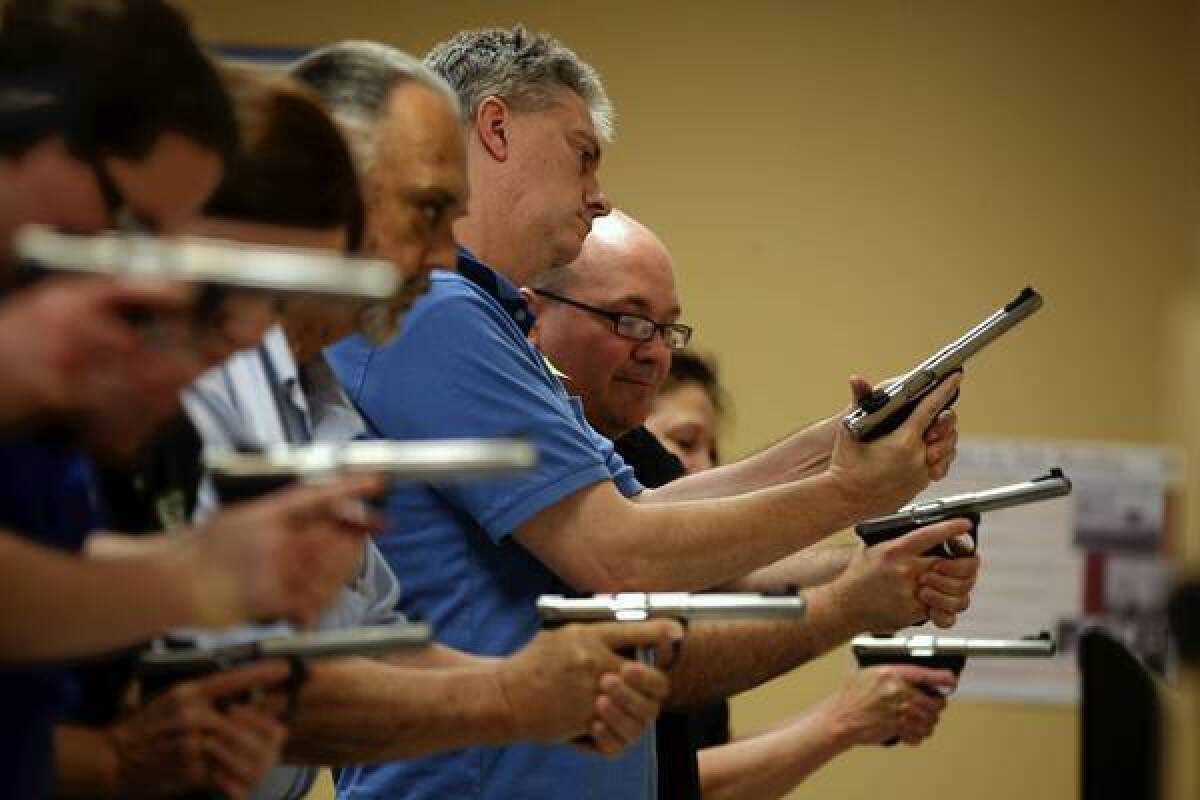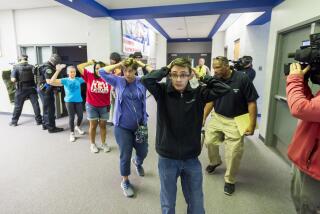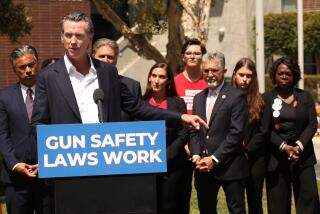Debate brews in Illinois over gun training requirements

CHICAGO — The classroom was dark and uncomfortably warm. A police scanner blared in the background, creating an annoying distraction.
Gregory Colon, in training to become a licensed armed security guard, was nervous when he entered the firearms class. The atmosphere was designed to add to the tension and get his heart rate up.
“We need to know what our body is going to do in a stressful situation,” instructor Andre J.W. Queen told the students. “If it’s not a deadly force threat, you should not be shooting at it.”
The simulated incidents Colon encountered — a hostage situation on a school bus, a shootout in a hallway and an attack by a man wielding a knife — were generated on a computer and projected onto a large screen. But Colon, armed with a SIRT laser gun that resembled a Glock 17 semiautomatic pistol, had to react as if he was in life-and-death situations.
“It was much more intense than I expected,” said Colon, 21, of Chicago, who shot his “attackers” in self-defense. “I was sweating and my palms were sticky. It shows in real life how fast you can get hurt.”
As the Illinois State Police work out the details of the new law giving Illinois citizens the right to carry firearms in public, a debate is brewing over the 16 hours of training it requires.
Some gun rights advocates argue that requiring essentially two days of training is excessive and unnecessarily prolongs the process for obtaining a permit. Others, including some firearms instructors, want to see Illinois adopt standards that go beyond the gun handling instruction and marksmanship offered in basic civilian firearms safety courses. They say it’s important to teach people not only how to shoot but how to defuse potentially dangerous situations so they don’t have to use a firearm.
“The concealed-carry permit, realistically, is only there for you to protect yourself. It’s not a license to go out and go looking for trouble or deal with a situation that is best left to law enforcement,” said Queen, executive director of the Fidelity Investigative Training Academy in Chicago.
“Law enforcement training is about securing and containing the danger,” he said. “Concealed-carry training is about protecting yourself and moving away from the danger.”
Ordinary citizens, armed or not, should never interject themselves into dangerous situations, instructors said. But simulated exercises like the one Colon participated in allow students to experience the psychological and physiological changes that firearms trainers say occur during an attack.
A rush of adrenaline causes the hands to shake. Blood flows away from the fingers and toes, dulling the senses. Motor skills weaken. The perception of time changes, making everything seem to move in slow motion. You lose peripheral vision, and it seems as though you’re looking through a tunnel.
“People need to think about what is happening when they’re stressed out,” Queen said. “They need to be trained to be aware of their surroundings, other people and other possible threats. They are not going to get that training at a [firearms] range where nobody is going to shoot back.”
Although the Illinois State Police has yet to issue specific guidelines for the training, Queen, also a certified National Rifle Assn. instructor, said he was developing a simulation program involving situations that average citizens might encounter, such as road rage or carrying a cash deposit from a business.
“If I go to a restaurant and step on your foot and we start slapping each other back and forth, I’m not expected to stand there and take it all day,” said Don Haworth, another NRA-certified instructor and owner of Chicagoland Firearm Training. “But I have to know what’s considered above and beyond.”
Before enrolling in Queen’s security guard course, Gloria Sauno said, she did not realize a gun should be the last resort.
“I thought if you came across a bad situation and you had a gun and training, you could use it,” she said. “Now I know that you have to sit back and hold on a second.”
Sauno’s pre-training assumption is what opponents of concealed weapons worry about most.
“I don’t think it will turn into the Wild West, but there are, potentially, things that can happen,” said Colleen Daley, executive director of the Illinois Campaign to Prevent Gun Violence. “It’s not the fear of someone walking down the street with a gun that bothers most people; it’s the unexpected consequences. Someone going out to have a drink does not intend on killing somebody, but it happens.”
More to Read
Start your day right
Sign up for Essential California for news, features and recommendations from the L.A. Times and beyond in your inbox six days a week.
You may occasionally receive promotional content from the Los Angeles Times.






